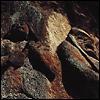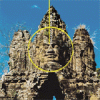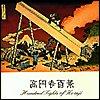
1-0 Reviews
Ruins/Tatsuya Yoshida
|
Albums:
Ruins
Stonehenge Hyderomast- groningem Refusal Fossil Symphonica Vrresto Mandala 2000/Live at Kichijoji Mandala II 1986-1992 Koenji-Hyakkei Hundred Sights Of Koenji Koenjihyakkei II Nivraym Tatsuya Yoshida A Million Years Tairikuotoko vs. Sanmyakuonna Viva Young Florida Korekyojin Korekyojin |

|
Links:
Magaibutsu Limited
Tatsuya Yoshida's record label Hisashi Sasaki Ruins bassist's homepage Sonore Records Ruins at this French label's page Ruins Discography "Unofficial," slightly out-of-date The Japanese Avant-Prog Short article about the current Japanese underground avant-prog scene. |

|

|
Stonehenge1990 |
Kinetic Japanese duo's fourth album overall, but first to be released outside of Japan. Features Tatsuya Yoshida (drums) and Kazuyoshi Kimoto (bass, violin). This band has carried on since 1986, led by Yoshida, playing a relentlessly harsh, agile, complicated form of prog-rock. Many critics have suggested Magma and King Crimson as influences, but this band is truely in a league of their own. This album suffers from below-average recording quality, but it doesn't take much effort to hear the energy in the combustible strains of Yoshida's angular, punk-induced riff workouts. Probably not the band to play on a first date.
Representative tracks
big head: Chaotic lead track from the album establishes mood for band's entire career. Moments of chaos juxtaposed with moments of odd-metered chaos, all to the tune of bloody yelps from Yoshida and Kimoto. Harsh.
|

|
|
|
Personnel:
Tatsuya Yoshida:
Kazuyoshi Kimoto: |
Hyderomastgroningem1995 |
Album released on John Zorn's Tzadik label. Features bassist Ryuichi Masuda, along with Yoshida (who, for the first time, didn't write all the tunes on a Ruins album).
The duo stretches themselves a bit here, incorporating free-improv, electronics, and longer song forms to make their most experimental album. If you've not heard the group, though, it's as good a place to start as any. As usual, the duo sings in a language invented by Yoshida (but very similar to Christian Vander's language for Magma), and the lyrics are printed in the CD insert. Yoshida has stated that they do not mean anything, and are generally just for effect. This album was probably the last of the prototypical Ruins releases, as heretofore the group would alter their style slightly, from a punk-zeuhl hybrid, to their current "complexicore" style, barely sticking with a riff long enough to discern what is actually being played. Many fans choose Hyderomastgroninem as their favorite release, and it is a good place to start if you want to investigate Ruins.
Representative tracks
Brixonvarromiks: Long track showcasing the band's talent for alternating quiet passages with chaotic ones. If the warbling operatic vocals don't appeal to you, maybe the distorted-schrapnel bass sound will. Relentless.
|

|
|
|
Personnel:
Tatsuya Yoshida:
Ryuichi Masuda: |
Refusal Fossil1997 |
Live and unreleased tracks from throughout the band's career.
Already prolific (Ruins released five albums in 1998 in one form or another), this disc collects crude recordings of previously unheard tracks, and a few from a '97 live show. Most of this album was recorded on 4- or 8-track, so the sound is raw to the extreme. The actual music is as good as anything the duo have released. From the Eastern European folksong influences in "Stara Planina" to the ridiculously compact "Prog Rock Medley," this album has something for everyone...who already likes Ruins.
Representative tracks
Refusal Fossil: From 1995, this heavy track features the usual oppressive percussion and distorted bass. The utter messiness of the recording (like much of the album) gives it a demo feel rather than that of a finished product. Tough.
|

|
|
|
Personnel:
Tatsuya Yoshida:
Hisashi Sasaki:
Ryuichi Masuda:
with |
Symphonica1998 |
Album wherein Yoshida enlists the help of a keyboard player and two female singers to "flesh out" several old Ruins tunes. He is also joined by his newest bassist (somewhat of a revolving-door position), Sasaki Hisashi.
The grating sound of previous albums is replaced with a bottom-heavy, thick stew of Magma-styled operatic vocals, ELP-styled keyboard flourishes, and the trademark Ruins stop-on-a-dime rhythm machine. Generally, the tunes are made much more "accessible" in this form. This project is very much related to another one of Yoshida's other bands, Koenjihyakkei, with lots of operatic singing and fancy, prog-rock honed instrumental embellishments.
Representative tracks
Graviyaunosch: This song was first featured on the duo's 1993 album of the same name. Here, the added keyboards, singers, and beefed-up production give the tune a metallic, 'zeuhl-ish' edge. For newcomers, this is probably the place to start, even if it's rather unrepresentative of their career.
|

|
|
|
Personnel:
Tatsuya Yoshida:
Hisashi Sasaki:
Oguchi Kenichi:
Emi Eleonola:
Aki Kubota: |
Vrresto1998 |
The duo picks up where it left off on "Hyderomastgroningem" with their usual hyperactivity.
Yoshida shares writing credits with his bassist on about half the tunes, though you'd be hard pressed to notice a huge difference. In retrospect, the band has gotten a little tighter since their earlier albums, but for overall career consistency, Ruins rival Burt Bacharach and Bob Hope.
Representative tracks
Warrido: Spirited track in the classic Ruins style. Many songs on this album are treated with a MIDI device hooked up to Hisashi's bass, giving the tunes a synth-like edge. Here, a goofy pogo-bass sound propells Yoshida's disco beat. Raw and fun.
|

|
|
|
Personnel:
Tatsuya Yoshida:
Hisashi Sasaki: |
Mandala 2000/Live at Kichijoji Mandala II2001 |
This album captures the duo in concert, performing tunes mostly from their last couple of albums, and a fair amount of improv. It's actually their first decently recorded live album, and is definitely the next best thing to witnessing their brand of carnage in person. Additionally, there are several tunes featuring violinist Katsui Yuji (Rovo, Bondage Fruit); the aesthetic remains essentially the same, albeit slightly more colorful.
And so we have yet another relentless Ruins album. I shouldn't have to tell you that these guys are an acquired taste for most people. For newcomers, I would advise starting out with one of the studio albums, such as Hyderomastgroningem, before diving in here. After that, check out Symphonica, which tones down the chaos but drastically increases the prog factor by adding keyboards and extra singers. And then, when you're ready to settle down to a night of thrills and spills, pop this one in.
Representative tracks
Gharaviss Perrdoh: There's still a discernible link to toe-tapping and fist-pumping anthem-and-roll here, though you may have to wade through a few layers of distortion to find it. This tune veers off the path with some fairly harsh-- even by Ruins standards-- group improvisation, but quickly rediscovers the groove as Sasaki's monster bass drives all its edges into the ground, while never betraying the studied dexterity it takes to pull this music off.
|

|
|
|
Personnel:
Tatsuya Yoshida:
Hisashi Sasaki: |
1986-19922002 |
For fans, a release like 1986-1992 is fine indeed. Skin Graft's compilation packages ridiculously rare early stuff like the original 1986 seven-inch of the band's first four-track recordings, their 1987 twelve-inch album, and selected tracks from their third record. Also included are tracks from two easier to find LP's, 1990's Stonehenge and 1992's Burning Stone. Yoshida remixed all the tracks last year, and I can tell you that, being familiar with the original albums, I was pretty shocked by the remixes. Very noisy! Its tracks seem to have been given that extra ear-bleeding remix treatment. Give Yoshida credit for creating the impression that all of this stuff was recorded at the same time in the same studio, with the same production.
Despite the ear-abuse, my only real caveat with the album is that fans will probably already own about half of it. Of course, the really early material makes it worthwhile for people like me. For newcomers, I'd suggest hunting down the above mentioned studio records for early Ruins, and work from there. Yoshida doesn't look like he's ever going to stop, so you have plenty of time to work your way through to this comp.
Representative tracks
Outburn: From 1986, at once the greatest-ever hardcore punk song not to protest anything or even feature real words in the lyrics, and a public service announcement for ADD awareness. The main riff is as stubbornly assured as anything Bad Brains put to wax, and the lest you get bored during its eight seconds, another wild-ass riff is there to take its place, and again and again. It seems like this kind of thing should have made the whole math-rock thing obsolete before it ever happened, but whatever.
|

|
|
|
Personnel:
Tatsuya Yoshida: |
Koenjihyakkei
Hundred Sights of Koenji1994 |
Debut album from Yoshida's 'orthodox' zeuhl band. Well, for those of you near and dear to Ruins, this band steers ever closer to those hallowed fields of yore, when foreign tongues, interplanetary wars, and distorted bass solos were all the rage. For those caught unawares, Zeuhl is the style of choice here, though certainly in much harder, more metallic casing than Christian Vander's guerillas could muster.
Tatsuya Yoshida is an elder statesmen of the Japanese underground scene, taking his cues from visionaries such as the above-noted Vander, as well as the RIO school, but filtering it through modern experimentalist theories as postulated by John Zorn and Keichi Haino. Where does this leave him? Scattered, to say the least. This band is one of dozens he is involved with; Yoshida usually favors a compartmentalized musical experience. Koenjihyakkei is, and is only, his tribute to zeuhl. Perhaps the most valuable player in the mix is singer/keyboardist Aki Kubota (formerly a member of Bondage Fruit). Her operatic, resonant vocal style suits this music to a tee, and it may be only for the sake of following the Magma tradition that the other group members even sing at all. She could easily front this band, or any other, all on her own. This album also features former Ruins bassist Masuda. Yoshida's group of friends seemingly covers all of Tokyo, but he works best when he's surrounded by people who know his style well.
Representative tracks
Doi Doi: Over-the-top theatrical metal. Begins peacefully enough with bells and Yoshida's distinct falsetto, but leads to a Zep-come-Crimson romp that would make Mothra proud.
|

|
|
|
Personnel:
Tatsuya Yoshida:
Aki Kubota:
Ryuichu Masuda:
Shigekazu Kuwahara: |
Koenjihyakkei II1997 |
Start here. That is, put down all your worn out copies of Hhai and Red and Ceux du Dehors, and start all over again with this. But you like all those old albums, right? Well, at the very least, you may need to add another to the pantheon.
Let me get the whole Tatsuya Yoshida/Ruins thing out of the way. Yes, this another of the prolific drummer's projects, and yes, as per usual, this is not for the faint of heart. However, just like the first Koenjihyakkei release, this one might just change your mind. Let's review: Magma-influenced, loud, sometimes fast, sometimes chaotic, very well produced (unlike some Yoshida releases), did I mention loud? Anyways, you get the idea. This could only happen in Japan in the 90s. Not for pregnant women or people with heart problems.
Representative tracks
Grembo Zavia: The ultimate accomplishment in Yoshida's ongoing quest to create the zaniest, heaviest Magma tribute ever. Fast, bass-heavy, angular, relentless, LOUD. If you can keep up, you're doing almost as well as Yoshida's bandmates.
|

|
|
|
Personnel:
Tatsuya Yoshida:
Aki Kubota:
Jin Harada:
Kengo Sakamoto: |
Nivraym2001 |
Koenji's third album, and for the record, it's even more overtly proggy than the first two. Aki Kubota left the band, and for those of you who thought she was irreplaceable, you're only half right: Oguchi Kenichi easily fulfills her old role as keyboardist, and the music seems to have been written to suit his strengths; and new vocalist Sagara Nami certainly has the vocal chops to pull off more than her fair share of theatrics. The biggest losses here seem to be Kubota's compositions, which were always among the band's most colorful. She will be missed, but even if the direction is slightly changed, the enthusiasm has not.
As mentioned, the focus has shifted a tad, with newfound emphasis on keyboard textures, and a whole new bag of solo breaks. The other Koenji albums stood out from the pack for any number of reasons, but in particular in their lack of flashy improv. Kenichi gets in his licks and then some, similar to Ruins' Symphonica, on which he impractically stole the show. In fact, much of this album reminds of Symphonica, also due to a slightly lighter sound than its predecessors. It's no cake walk, but it's not quite the overloaded powderkeg of II either. This suits the synths, as well as the vocal lines, which are still closer to that hallowed qualifier of lore known as 'almost normal'. Normal is relative of course, and here, it refers mostly to zeuhl heritage, and the occasional dramatic soprano lead. Instrumentally, the band plays fairly close to hard-edged RIO, with minute dashes of good old Ruins-style chaos.
Representative tracksBecttem Pollt: Hyper symphonic prog tune featuring the fiery fingers of Oguchi and the Yoshida's ever-restless time keeping. Like a few other tunes on the album, this wouldn't have been out of place on Symphonica, except for the massed vocals. The real shows here are the synth lines, and the usual rhthym acrobatics. Compact yet overloaded - how's that for summarizing a Yoshida piece? Gassttrumm: Their latest classic monster zeuhl epic. This time around, we've got a very foreboding intro, with pounding piano and martial drums, on to a typically impending vocal/bass unison chant, leading to one of the more hair-raising soprano leads you'll ever hear. Later, some fine spastic riffing, and even further on a scorching Oguchi solo. Like a lot of Yoshida stuff, it comes back full circle at the end, and I'm beginning to wonder if he writes these tunes for breakfast. |

|
|
|
Personnel:
Yoshida Tatsuya: |
Tatsuya Yoshida
Tairikuotoko vs. Sanmyakuonna
Korekyojin
Korekyojin1999 |
Drums, bass, and guitar trio from the man who brought you Ruins and Koenjihyakkei.
Tatsuya Yoshida's latest project sees him visiting the RIO prog-rock flavor of such bands as Henry Cow and The Muffins. He enlisted the help of guitarist Kido Natsuki, formerly of Bondage Fruit, who greatly contributes to the angular, dissonant, messy groove. Whereas Ruins, Koenjihyakkei, and other Yoshida projects emit an air of lightheartedness, Korekyojin is a workout, heavy on group improvisation and complicated, polyrythmic exercises. Kido occasionally brings a funk-tinged chicken scratch to the table, but for the most part be prepared for no-frills, avant-complexicore.
Representative tracks
Four Holes In the Sky: Odd-metered highhat/snare pattern is transformed into a typically knee-buckling head, followed by group improv. Tough, dissonant, scrambled. If you can't stand This Heat, get out of the kitchen.
|

|
|
|
Personnel:
Tatsuya Yoshida:
Natsuki Kido:
Mitsuru Nansuno: |



